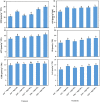Coapplication of Effective Microorganisms and Nanomagnesium Boosts the Agronomic, Physio-Biochemical, Osmolytes, and Antioxidants Defenses Against Salt Stress in Ipomoea batatas
- PMID: 35909720
- PMCID: PMC9326395
- DOI: 10.3389/fpls.2022.883274
Coapplication of Effective Microorganisms and Nanomagnesium Boosts the Agronomic, Physio-Biochemical, Osmolytes, and Antioxidants Defenses Against Salt Stress in Ipomoea batatas
Abstract
The application of bio- and nanofertilizers are undoubtedly opening new sustainable approaches toward enhancing abiotic stress tolerance in crops. In this study, we evaluated the application of effective microorganisms (EMs) of five groups belonging to photosynthetic bacteria, lactic acid bacteria, yeast, actinobacteria, and fermenting fungi combined with magnesium oxide (MgO) nanoparticles (MgO-NP) on the growth and productivity of sweet potato plants grown in salt-affected soils. In two field experiments carried out in 2020 and 2021, we tested the impacts of EMs using two treatments (with vs. without EMs as soil drench) coupled with three foliar applications of MgO-NP (0, 50, and 100 μg ml-1 of MgO, representing MgO-NP0, MgO-NP50, and MgO-NP100, respectively). In our efforts to investigate the EMs:MgO-NP effects, the performance (growth and yield), nutrient acquisition, and physio-biochemical attributes of sweet potatoes grown in salt-affected soil (7.56 dS m-1) were assessed. Our results revealed that salinity stress significantly reduced the growth parameters, yield traits, photosynthetic pigment content (chlorophylls a and b, and carotenoids), cell membrane stability, relative water content, and nutrient acquisition of sweet potatoes. However, the EMs+ and/or MgO-NP-treated plants showed high tolerance to salt stress, specifically with a relatively superior increase when any of the biostimulants were combined. The application of EMs and/or MgO-NP improved osmotic stress tolerance by increasing the relative water content and membrane integrity. These positive responses owed to increase the osmolytes level (proline, free amino acids, and soluble sugars) and antioxidative compounds (non-enzymatic concentration, enzymatic activities, phenolic acid, and carotenoids). We also noticed that soil salinity significantly increased the Na+ content, whereas EMS+ and/or MgO-NP-treated plants exhibited lower Na+ concentration and increased K+ concentration and K+/Na+ ratio. These improvements contributed to increasing the photosynthetic pigments, growth, and yield under salinity stress. The integrative application of EMs and MgO-NP showed higher efficacy bypassing all single treatments. Our findings indicated the potential of coapplying EMs and MgO-NP for future use in attenuating salt-induced damage beneficially promoting crop performance.
Keywords: abiotic stress; antioxidant; osmoprotectants; salinity; sweet potato; tuber yield.
Copyright © 2022 Abd El-Mageed, Gyushi, Hemida, El-Saadony, Abd El-Mageed, Abdalla, AbuQamar, El-Tarabily and Abdelkhalik.
Conflict of interest statement
The authors declare that the research was conducted in the absence of any commercial or financial relationships that could be construed as a potential conflict of interest.
Figures


Similar articles
-
Enhancing sweet potato (Ipomoea batatas) resilience grown in cadmium-contaminated saline soil: a synergistic approach using Moringa leaf extract and effective microorganisms application.Environ Sci Pollut Res Int. 2024 May;31(22):32464-32479. doi: 10.1007/s11356-024-33295-w. Epub 2024 Apr 23. Environ Sci Pollut Res Int. 2024. PMID: 38653894 Free PMC article.
-
Soil application of effective microorganisms and nitrogen alleviates salt stress in hot pepper (Capsicum annum L.) plants.Front Plant Sci. 2023 Jan 18;13:1079260. doi: 10.3389/fpls.2022.1079260. eCollection 2022. Front Plant Sci. 2023. PMID: 36743545 Free PMC article.
-
Impact of Exogenously Sprayed Antioxidants on Physio-Biochemical, Agronomic, and Quality Parameters of Potato in Salt-Affected Soil.Plants (Basel). 2022 Jan 14;11(2):210. doi: 10.3390/plants11020210. Plants (Basel). 2022. PMID: 35050098 Free PMC article.
-
Agroindustrial By-Products as a Source of Biostimulants Enhancing Responses to Abiotic Stress of Horticultural Crops.Int J Mol Sci. 2024 Mar 20;25(6):3525. doi: 10.3390/ijms25063525. Int J Mol Sci. 2024. PMID: 38542496 Free PMC article. Review.
-
Salinity Stress in Potato: Understanding Physiological, Biochemical and Molecular Responses.Life (Basel). 2021 Jun 10;11(6):545. doi: 10.3390/life11060545. Life (Basel). 2021. PMID: 34200706 Free PMC article. Review.
Cited by
-
Effect of Co-Application of Azospirillum brasilense and Rhizobium pisi on Wheat Performance and Soil Nutrient Status under Deficit and Partial Root Drying Stress.Plants (Basel). 2023 Aug 31;12(17):3141. doi: 10.3390/plants12173141. Plants (Basel). 2023. PMID: 37687389 Free PMC article.
-
Integrative application of licorice root extract and melatonin improves faba bean growth and production in Cd-contaminated saline soil.BMC Plant Biol. 2025 Jan 8;25(1):26. doi: 10.1186/s12870-024-05954-0. BMC Plant Biol. 2025. PMID: 39773343 Free PMC article.
-
A Novel Nutrient- and Antioxidant-Based Formulation Can Sustain Tomato Production under Full Watering and Drought Stress in Saline Soil.Plants (Basel). 2023 Sep 27;12(19):3407. doi: 10.3390/plants12193407. Plants (Basel). 2023. PMID: 37836147 Free PMC article.
-
Nano-Restoration for Sustaining Soil Fertility: A Pictorial and Diagrammatic Review Article.Plants (Basel). 2022 Sep 14;11(18):2392. doi: 10.3390/plants11182392. Plants (Basel). 2022. PMID: 36145792 Free PMC article. Review.
-
Development of a Multicomponent Microbiological Soil Inoculant and Its Performance in Sweet Potato Cultivation.Microorganisms. 2023 Mar 31;11(4):914. doi: 10.3390/microorganisms11040914. Microorganisms. 2023. PMID: 37110337 Free PMC article.
References
-
- Abd El-Mageed T. A., El-sherif A. M. A., Abd El-Mageed S. A., Abdou N. M. (2019). A novel compost alleviate drought stress for sugar beet production grown in Cd-contaminated saline soil. Agric. Water Manag. 226:105831. 10.1016/j.agwat.2019.105831 - DOI
-
- Abd El-Mageed T. A., Rady M. M., Taha R. S., El Azeam S., Simpson C. R., Semida W. M. (2020). Effects of integrated use of residual sulfur-enhanced biochar with effective microorganisms on soil properties, plant growth and short-term productivity of Capsicum annuum under salt stress. Sci. Hortic. 261:108930. 10.1016/j.scienta.2019.108930 - DOI
-
- Abdelkhalik A., Pascual-Seva N., Nájera I., Domene M. Á, Baixauli C., Pascual B. (2019). Effect of deficit irrigation on the productive response of drip-irrigated onion (Allium cepa L.) in mediterranean conditions. Hortic. J. 88 488–498. 10.2503/hortj.UTD-081 - DOI
-
- Acosta-Motos J. R., Ortuño M. F., Bernal-Vicente A., Diaz-Vivancos P., Sanchez-Blanco M. J., Hernandez J. A. (2017). Plant responses to salt stress: adaptive mechanisms. Agronomy 7:18. 10.3390/agronomy7010018 - DOI
LinkOut - more resources
Full Text Sources
Miscellaneous

